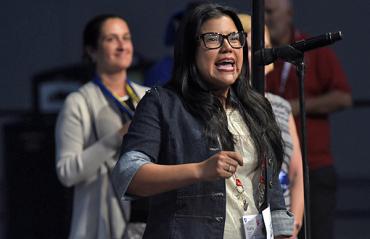After a long stream of delegates shared their stories of success, counting up thousands of recommitted members and new members, it was clear that three resolutions related to member engagement and the future of the union would pass when they came to a vote on Sunday. Resolutions 43, 44 and 45, on external organizing, the future of our union and building union power, passed easily.
“Organizing is the lifeblood of every union,” said David Hecker, the president of AFT Michigan and an AFT vice president. “Given Janus, it’s imperative that we double down on our commitment to organize. … To quote [union activist] Joe Hill, ‘Don’t mourn. Organize, organize, organize.’”
That’s just what many locals have been doing. “We are alive and well, and we are ready for our fight,” said Michael Mulgrew, the president of the United Federation of Teachers and an AFT vice president. “UFT now has over 8,000 new union activists who have formed ambassador teams at every worksite in New York City. We are now at our highest percentage ever of 99.27 percent full membership.”
David Cicarella, president of the New Haven Federation of Teachers in Connecticut, said his local is at nearly 100 percent recommitment. Tony Johnston, president of the Cook County College Teachers Union in Chicago, reported 100 percent recommitment in eight of CCCTU’s chapters. Wayne Spence, president of Public Employees Federation in New York, reported 96 percent recommitments and since Janus was decided, a 200 to 1 recommitment rate. Andrea Vasquez, an officer with the Professional Staff Congress at the City University of New York, said full-time membership there is 96 percent, and more than 525 members either joined or recommitted in the two weeks after the Janus case was decided. Karla Hernandez-Mats (pictured above), president of the United Teachers of Dade in Florida, said her local recruited 3,208 new members. Rick Lucas, a member of the Ohio Nurses Association, recommitted more than 3,000 members and 100 additional activists.
After recounting the many instances of AFT members rising up across the nation, Zeph Capo, president of the Houston Federation of Teachers, said, “Own your power, brothers and sisters!”
Resolution 43: External Organizing
This resolution recognizes that there are “individuals who want to defund and destabilize organized labor” who are working “toward their goal of massive disinvestment in public services, quality healthcare and public schools,” but simultaneously describes “an activist spirit [that is] spreading across the country, as the teacher walkouts and student movements for safety demonstrate.” The resolution also describes the challenges posed by “incessant attempts to silence employees and restrict unions,” notes the robust membership that already exists—the AFT is now one of the world’s largest healthcare unions and the largest union for higher education workers in the country—and resolves to expand membership in every division.
Resolution 44: The Future of Our Union
This resolution also recognizes the threats to labor, including “the Kochs, the DeVoses and their corporate allies,” who are “going after public education, the right to vote and labor unions.” Countering those forces is “a huge appetite to mobilize and fight back,” the resolution notes. But while the union has always worked for justice and democracy, the resolution goes on to suggest that “strategies and structures may have to change,” and resolves to “look at our union’s structure and strategies—top to bottom and bottom to top—with an eye toward making necessary change for the 2020 convention” and establishing a “Futures process,” which would include the AFT president, the executive council and input from rank-and-file members and elected leaders at all levels of the union. The process would culminate with a report and action plan to be considered by the delegates to the 2020 AFT convention.
Resolution 45: Building Union Power
This resolution catalogs the many ways the AFT already fights back against “corporate interests and the privileged wealthy,” at the forefront of the battle against austerity policies that defund public education and public services, blocking efforts to abolish payroll deduction of membership dues, defeating union-busting tactics, opposing school closings and even increasing membership density. The resolution goes on with a promise to continue organizing efforts to strengthen local affiliates “so they may carry forward the fight to make sure the values we share are reflected in public policies and in the allocation of public resources.” It pledges to “redouble our efforts” to “secure the resources and autonomy we need to help children success and to defeat attempts to defund and privatize our public schools.” At the same time, the resolution renews a commitment to majority unionism, pledges to increase efforts to build internal structure and pledges to continue to stand up and persevere against union-busting legislation promoted by anti-union forces across the nation.
[Virginia Myers, photo by Michael Campbell]

